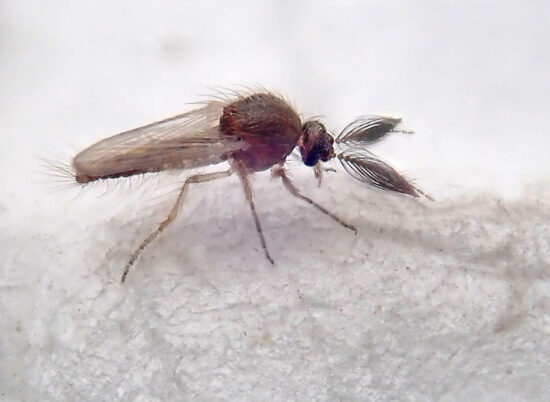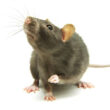If you’ve ever been outside on a beautiful evening only to get attacked by invisible biting insects, you’ve met no-see-ums. These tiny pests are so small you can barely see them, but their painful bites can ruin any outdoor activity.
The good news is that learning how to get rid of no-see-ums is pretty simple! Here are some methods we like.
1. Remove All Standing Water
This is your first line of defense and honestly the most important step you can take. No-see-ums need still water to breed, so removing every source of standing water around your home cuts off their ability to reproduce.
Walk around your property and dump out anything that holds water. This includes bird baths, plant saucers, kids’ toys, empty flower pots, and portable pools. Don’t forget about less obvious spots like clogged gutters, tire swings, or that old bucket hiding behind the shed.
- 4200V electric grid zaps mosquitoes, flies, moths, and gnats fast
- Covers up to ½ acre—great for patios, gardens, and camping
- Chemical-free pest control, safe around pets and kids
- Easy setup with hanging loop, removable tray, and replaceable bulb
Here’s the thing that might surprise you: even a few tablespoons of water can attract a whole group of no-see-ums to your yard. That small amount might not seem like much to you, but it’s like a five-star resort to these pests. Make it a habit to check for standing water after every rain or watering session.
2. Clean and Maintain Gutters
Clogged gutters are like luxury condos for no-see-ums. They provide everything these pests need: standing water, decaying organic matter, and protection from wind and sun.
Clean your gutters at least twice a year, and more often if you have lots of trees around your house. Install gutter guards to keep leaves and debris from building up in the first place. When gutters flow properly, water moves away from your house instead of sitting there creating perfect breeding conditions.
Don’t just focus on the gutters themselves. Check your downspouts too. Sometimes they can get clogged at the bottom, causing water to back up and pool in unexpected places.
3. Improve Yard Drainage
Take a walk around your yard after the next heavy rain. Any spots where water pools for more than a day or two need attention. These low areas are prime real estate for no-see-ums looking to lay eggs.
Fill in these depressions with soil or sand. For larger problem areas, you might need to install drainage systems or French drains. Aerate your lawn annually to help water soak into the ground instead of running off and pooling elsewhere.
If you’re planning any landscaping projects, think about drainage from the start. Grade your yard so water flows away from your house and outdoor living areas. Your future self will thank you when you’re not dealing with swarms of biting insects.
4. Fix All Water Leaks
No-see-ums have an amazing ability to find even the smallest sources of moisture. That dripping outdoor faucet or leaking sprinkler head might not seem like a big deal, but it’s creating the perfect environment for these pests to breed.
Check all your outdoor plumbing regularly. Don’t forget about air conditioning units, which can create surprisingly large puddles if the drainage isn’t working properly. Even indoor leaks can cause problems if water is seeping into crawl spaces or basements.
The good news is that fixing these leaks will save you money on your water bill while also helping with pest control. It’s a win-win situation.
5. Trim Vegetation and Improve Sunlight
No-see-ums love shady, humid spots where they can hide during the day. Dense vegetation that blocks sunlight and airflow creates the perfect microclimate for these pests.
Prune back overgrown bushes and trees, especially around water features and outdoor seating areas. The goal is to let in more sunlight and improve air circulation. When areas dry out faster after rain or watering, they become much less attractive to no-see-ums.
Pay special attention to plants near your house, deck, or patio. These are the areas where you spend time outdoors, so keeping them sunny and breezy will make your outdoor experience much more pleasant.
6. Use Fine Mesh Screens (16-18 Mesh or Finer)
Here’s something that catches many people off guard: regular window screens won’t keep no-see-ums out. These tiny insects can easily slip through the holes in standard mosquito screening.
You need screens with much smaller openings, specifically 16-18 mesh or finer. These screens are sometimes called “no-see-um screens” and they’re designed exactly for this problem. Yes, they can reduce airflow a bit, but the trade-off is worth it when you’re not getting bitten inside your own home.
- 4200V electric grid zaps mosquitoes, flies, moths, and gnats fast
- Covers up to ½ acre—great for patios, gardens, and camping
- Chemical-free pest control, safe around pets and kids
- Easy setup with hanging loop, removable tray, and replaceable bulb
When installing fine mesh screens, make sure they fit tightly with no gaps around the edges. Even a small opening can let these persistent pests inside.
7. Install and Use Fans Strategically
This might be the easiest and most immediately effective solution on this list. No-see-ums are terrible fliers, and even a gentle breeze can keep them away from you.
Set up ceiling fans on covered porches and patios. Use portable fans for outdoor dining or relaxation areas. Point box fans toward seating areas to create a protective barrier of moving air.
The great thing about fans is that they work instantly. As soon as you turn them on, you’ll notice fewer no-see-ums in the area. Plus, fans keep you cooler during hot weather, so you get double benefits.
8. Apply DEET-Based Repellents
DEET gets a bad reputation sometimes, but when figuring out how to get rid of no-see-ums, it’s one of the most effective weapons available. The key is using products specifically labeled for biting midges or no-see-ums, not just general bug sprays.
Read the label carefully and follow the application instructions exactly. Many people think they know how to apply insect repellent, but they don’t use enough or don’t reapply when needed. This leaves them vulnerable to bites.
Apply DEET repellent to all exposed skin, including often-forgotten areas like the back of your neck, ankles, and wrists. These are favorite target spots for no-see-ums.
9. Try Picaridin Repellents
If you don’t like DEET or want an alternative, picaridin is an excellent option. It repels no-see-ums for 8 to 14 hours and doesn’t have the strong smell or greasy feel that some people dislike about DEET.
Picaridin is also less likely to damage plastics and synthetic materials, which makes it great for outdoor gear. It’s considered safe for daily use and is recommended by many health organizations.
Look for lotions or sprays containing picaridin and apply them just like you would any other insect repellent. The protection lasts longer than many other options, so you won’t need to reapply as often.
10. Use Oil of Lemon Eucalyptus
This plant-based repellent is a favorite among people who prefer natural options. Research shows that eucalyptus-based repellents can provide 98% protection from no-see-um bites for up to 8 hours.
Oil of lemon eucalyptus (also called PMD) works similarly to low concentrations of DEET but comes from a natural source. It has a pleasant, citrusy smell that most people find much more appealing than chemical repellents.
You can buy commercial products containing oil of lemon eucalyptus, or make your own blend with pure essential oil and a carrier oil. Just remember that natural doesn’t always mean gentler, so test any new product on a small area of skin first.
11. Create Essential Oil Repellent Sprays
Making your own no-see-um repellent can be both effective and economical. If you’re interested in natural approaches for how to get rid of no-see-ums, this is an excellent option. The key is using the right essential oils in the proper concentrations.
The most effective oils against no-see-ums are lemon eucalyptus, mint, camphor, citronella, and lemon. Mix these oils with a carrier like witch hazel, vodka, or a neutral oil using a 2 to 5% dilution ratio. For example, add about 1 ounce of essential oils to 19 ounces of carrier liquid.
Store your homemade repellent in a dark bottle and shake well before each use. The protection typically lasts 3 to 6 hours, so you’ll need to reapply more often than commercial repellents.
12. Plant Natural Repellent Gardens
Certain plants naturally repel no-see-ums by releasing compounds these insects can’t stand. Planting these around your outdoor living spaces creates a natural barrier against biting pests.
Great options include citronella, marigolds, basil, lavender, mint, and eucalyptus. Place potted versions on patios and porches so you can move them around as needed. Plant larger specimens in garden beds near seating areas and walkways.
These plants serve double duty by beautifying your space while providing pest protection. Many of them also repel mosquitoes and other flying insects, giving you broader protection from biting pests.
- 4200V electric grid zaps mosquitoes, flies, moths, and gnats fast
- Covers up to ½ acre—great for patios, gardens, and camping
- Chemical-free pest control, safe around pets and kids
- Easy setup with hanging loop, removable tray, and replaceable bulb
13. Use Permethrin-Treated Clothing
For serious protection, especially if you work outdoors or live in an area with heavy no-see-um populations, permethrin-treated clothing is a game changer. This treatment kills no-see-ums on contact and lasts through multiple washings.
You can buy pre-treated clothing or treat your own clothes and gear with permethrin spray. Focus on items you wear most often outdoors, like work clothes, gardening outfits, or camping gear.
Permethrin is safe for humans once it dries but deadly to insects. It’s particularly effective because it continues working even when you’re not actively applying repellent to your skin.
14. Wear Protective Clothing
Sometimes the simplest solutions are the most effective. Covering up exposed skin dramatically reduces the surface area available for no-see-ums to bite.
Wear long sleeves, long pants, tall socks, and closed shoes during peak activity times. Choose loose-fitting clothes because no-see-ums can bite through tight fabric that’s pressed against your skin.
Light-colored clothing is generally better than dark colors, which seem to attract more biting insects. If you’re going to be outside for extended periods, tuck your pants into your socks and your shirt into your pants to eliminate gaps where insects can sneak in.
15. Avoid Peak Activity Times
No-see-ums are most active during dawn and dusk hours. If possible, plan outdoor activities for mid-morning through mid-afternoon when these pests are less active.
Of course, dawn and dusk are often the most pleasant times to be outside, especially during hot weather. If you must be outdoors during these peak times, use multiple protection methods at once. Combine repellents, protective clothing, and fans for maximum effectiveness.
Even a short delay can help. Instead of having your morning coffee on the patio right at sunrise, wait an hour or two. Similarly, evening activities can often be moved earlier or later to avoid the worst of the no-see-um activity.
16. Install CO2 Traps
Carbon dioxide traps work by mimicking human breathing patterns to lure no-see-ums away from you. For homeowners serious about how to get rid of no-see-ums permanently, these devices represent one of the most advanced solutions available. These devices release CO2, heat, and sometimes other attractants to draw insects into a vacuum or adhesive trap.
Quality CO2 traps start around $300, which is a significant investment. However, they can be extremely effective when placed correctly near entry points and outdoor seating areas. The best part is that they work 24/7 without any effort from you.
Position traps between no-see-um breeding areas and the places where you spend time. This intercepts the insects before they reach you. Some models also work against mosquitoes and other flying pests, giving you broader protection.
17. Set Up Light Traps
Light traps use UV bulbs to attract no-see-ums, then capture them with fans or adhesive surfaces. These work best in darker areas where the light is more attractive to insects.
Place light traps near doorways and windows where no-see-ums might try to enter your home. They’re also effective on porches and patios, especially if you turn off other lights in the area.
The main advantage of light traps is that they’re relatively inexpensive and easy to maintain. Just empty the collection chamber regularly and replace bulbs when they burn out.
18. Make DIY Vinegar Traps
For a simple, cheap trap you can make at home, try the apple cider vinegar method. Pour vinegar into small bowls or jars, add a few drops of dish soap, and place them around problem areas.
The vinegar attracts no-see-ums while the soap breaks the surface tension of the liquid, causing the insects to drown. This won’t eliminate large populations, but it can help reduce numbers in specific areas like patios or outdoor dining spaces.
Replace the vinegar mixture every few days or when it gets full of insects. You can enhance the trap by adding a small amount of sugar or fruit juice to make it even more attractive.
19. Use Air Conditioning and Dehumidifiers
No-see-ums can’t tolerate cold temperatures and low humidity. Running your air conditioning not only keeps you comfortable but also creates an environment these pests can’t survive in.
For areas without air conditioning, dehumidifiers can help by reducing moisture levels. This is particularly useful in basements, crawl spaces, and other areas where humidity tends to build up.
The downside is that this approach can increase your electricity bills. However, if you’re dealing with a serious no-see-um problem, the comfort and bite prevention might be worth the extra cost.
20. Turn Off Outdoor Lights
Like many flying insects, no-see-ums are attracted to light sources. Keeping outdoor lights off when you’re not using outdoor spaces reduces this attraction.
When you do need outdoor lighting, consider using yellow or amber bulbs instead of white lights. These wavelengths are less attractive to most flying insects while still providing adequate illumination for human activities.
Close blinds and curtains at night to prevent indoor lights from attracting no-see-ums to your windows and doors. This simple step can significantly reduce the number of insects trying to get into your home.
21. Apply Professional Yard Treatments
Sometimes you need to bring in the big guns. Professional pest control companies understand exactly how to get rid of no-see-ums on a larger scale and can apply barrier sprays that kill adult no-see-ums on contact and provide residual protection for 2 to 3 weeks.
These treatments typically use synthetic compounds derived from chrysanthemum flowers, which are toxic to insects but relatively safe for humans and pets when applied properly. The treatments focus on areas where no-see-ums rest during the day, like mulch beds, under decks, and around vegetation.
If you prefer to do it yourself, you can buy similar products and apply them with a pump sprayer. Focus on mulch beds, flower gardens, lawn areas, and anywhere else you’ve noticed no-see-um activity.
22. Use Natural Yard Sprays
For those who prefer natural options, essential oil-based yard sprays can provide some protection without harsh chemicals. Mix citronella, eucalyptus, and mint oils with water and spray around outdoor areas.
These natural treatments typically don’t last as long as chemical options, so you’ll need to reapply more frequently. However, they’re safer around children, pets, and beneficial insects like bees and butterflies.
You can also find commercial natural yard sprays that combine multiple essential oils in effective concentrations. These save you the trouble of mixing your own while still providing plant-based protection.
23. Cover Compost and Garbage
No-see-ums feed on decaying organic matter, so exposed compost piles and open garbage cans are like restaurants to these pests. Keep compost bins covered with tight-fitting lids and make sure garbage cans close securely.
Don’t leave pet food bowls outside longer than necessary, and clean up any spilled birdseed or other organic matter. Even small amounts of decaying plant material can attract no-see-ums to your yard.
If you have fruit trees, clean up fallen fruit regularly. The fermenting fruit creates an irresistible attraction for many flying insects, including no-see-ums.
24. Maintain Regular Yard Care
A well-maintained yard is less attractive to no-see-ums than an overgrown, messy one. Regular mowing, weeding, and cleanup eliminate hiding spots and reduce moisture retention.
Remove leaf litter, especially in areas that stay damp. Trim back overgrown vegetation near water sources. Keep grass cut short, particularly in areas where you spend time outdoors.
During fall cleanup, don’t let organic matter pile up in corners or under decks. These areas can hold moisture and provide overwintering sites for various pests.
25. Monitor and Treat Early in Season
Prevention is always easier than elimination. When planning how to get rid of no-see-ums for the long term, start your control program in early spring before populations have a chance to build up.
This means cleaning up standing water, applying preventive treatments, and setting up traps before you start noticing bites. By the time you’re getting bitten regularly, the population is already established and much harder to control.
Keep a record of when no-see-ums typically become active in your area. This helps you time your prevention efforts for maximum effectiveness. Most areas see peak activity from late spring through early fall, but this varies by climate and location.



